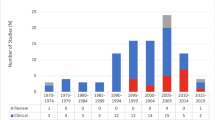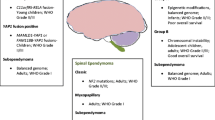Abstract
The prognosis for patients diagnosed with ependymoma is relatively poor, with a 5-year overall survival rate of 24–75%. Currently, tumors are treated by surgical resection followed by radiotherapy, as resection is the most consistent prognostic marker (up to 80%). Therefore, there is a pressing need to improve our understanding of the biology of these tumors and to develop new therapeutic targets. The present work was a systematic review of the current molecular knowledge of pediatric ependymomas. From January 2000 to December 2017, we carried out a search using “MeSH” (Medical Subject Heading), and “free-text” protocols in the databases Medline/PubMed, SCOPUS, Web of Science, and EMBASE (OVID platform), combining the terms chromosomal alterations, genetic changes, epigenetic changes, and protein expression changes. We selected articles with samples from pediatric patients and chose publications with complete clinical features. Only 33 articles met the criteria for a meta-analysis, suggested by the state of methylation and expression of a characteristic marker of pediatric ependymomas. We found a chromosomal alteration and one gene associated with survival; these are candidates for bad prognosis biomarkers.




Similar content being viewed by others
References
Ammerlaan ACJ, De Bustos C, Ararou A. Localization of a putative low-penetrance ependymoma susceptibility locus to 22q11 using a chromosome 22 tiling-path genomic microarray. Genes Chromosom Cancer. 2005;43:329–38.
Rogers HA, Kilday JP, Mayne C. Supratentorial and spinal pediatric ependymomas display a hypermethylated phenotype which includes the loss of tumor suppressor genes involved in the control of cell growth and death. Acta Neuropathol. 2012;123:711–25.
Nambirajan A, Sharma MC, Gupta RK. Study of stem cell marker nestin and its correlation with vascular endothelial growth factor and microvascular density in ependymomas. Neuropathol Appl Neurobiol. 2014;40:714–25.
Lukashova-v. Zangen I, Kneitz S, Monoranu CM. Ependymoma gene expression profiles associated with histological subtype, proliferation, and patient survival. Acta Neuropathol. 2007;113:325–37.
Modena P, Buttarelli FR, Miceli R. Predictors of outcome in an AIEOP series of childhood ependymomas: a multifactorial analysis. 2012; 14: 1346–1356.
Higgins JPT, Thompson SG, Deeks JJ. Measuring inconsistency in meta-analyses need for consistency, https://www.ncbi.nlm.nih.gov/pmc/articles/PMC192859/pdf/3270557.pdf Accessed 28 June 2018.
Higgins JPT, Thompson SG. Quantifying heterogeneity in a meta-analysis. Stat Med. 2002;21:1539–58.
Begg CB, Mazumdar M. Operating characteristics of a rank correlation test for publication bias. Biometrics. 1994;50:1088–101.
Egger M, Smith GD, Schneider M. Bias in meta-analysis detected by a simple, graphical test. BMJ. 1997;315:629–34.
DerSimonian R, Laird N. Meta-analysis in clinical trials. Control Clin Trials. 1986;7:177–88.
Suzuki SO, Iwaki T. Amplification and overexpression of mdm2 gene in ependymomas. Mod Pathol. 2000;13:548–53.
Lamszus K, Lachenmayer L, Heinemann U. Molecular genetic alterations on chromosomes 11 and 22 in ependymomas. Int J Cancer. 2001;91:803–8.
Hirose Y, Aldape K, Bollen A. Chromosomal abnormalities subdivide ependymal tumors into clinically relevant groups. Am J Pathol. 2001;158:1137–43.
Ward S, Harding B, Wilkins P. Gain of 1q and loss of 22 are the most common changes detected by comparative genomic hybridisation in paediatric ependymoma. Genes Chromosom Cancer. 2001;32:59–66.
Dyer S, Prebble E, Davison V. Genomic imbalances in pediatric intracranial ependymomas define clinically relevant groups. Am J Pathol. 2002;161:2133–41.
Gilbertson RJ, Bentley L, Hernan R. ERBB receptor signaling promotes ependymoma cell proliferation and represents a potential novel therapeutic target for this disease. Clin Cancer Res. 2002;8:3054–64.
Jeuken JWM, Sprenger SHE, Gilhuis J. Correlation between localization, age, and chromosomal imbalances in ependymal tumours as detected by CGH. J Pathol. 2002;197:238–44.
Singh PK, Gutmann DH, Fuller CE. Differential involvement of protein 4.1 family members DAL-1 and NF2 in intracranial and intraspinal ependymomas. Mod Pathol. 2002;15:526–31.
Zamecnik J, Snuderl M, Eckschlager T. Pediatric intracranial ependymomas: prognostic relevance of histological, immunohistochemical, and flow cytometric factors. Mod Pathol. 2003;16:980–91.
Waha A, Koch A, Hartmann W. Analysis of HIC-1 methylation and transcription in human ependymomas. Int J Cancer. 2004;110:542–9.
Tabori U, Ma J, Carter M. Human telomere reverse transcriptase expression predicts progression and survival in pediatric intracranial ependymoma. J Clin Oncol. 2006;24:1522–8.
Karakoula K, Suarez-Merino B, Ward S. Real-time quantitative PCR analysis of pediatric ependymomas identifies novel candidate genes including TPR at 1q25 and CHIBBY at 22q12–q13. Genes Chromosomes Cancer. 2008;47:1005–22.
Monoranu CM, Huang B, Zangen IL Correlation between 6q25.3 deletion status and survival in pediatric intracranial ependymomas. Cancer Genet Cytogenet 2008; 182: 18–26.
Pezzolo A, Capra V, Raso A. Identification of novel chromosomal abnormalities and prognostic cytogenetics markers in intracranial pediatric ependymoma. Cancer Lett. 2008;261:235–43.
Rand V, Prebble E, Ridley L. Investigation of chromosome 1q reveals differential expression of members of the S100 family in clinical subgroups of intracranial paediatric ependymoma. Br J Cancer. 2008;99:1136–43.
Snuderl M, Chi SN, De Santis SM. Prognostic value of tumor microinvasion and metalloproteinases expression in intracranial pediatric ependymomas. J Neuropathol Exp Neurol. 2008;67:911–20.
Puget S, Grill J, Valent A. Candidate genes on chromosome 9q33–34 involved in the progression of childhood ependymomas. J Clin Oncol. 2009;27:1884–92.
Rousseau A, Idbaih A, Ducray F. Specific chromosomal imbalances as detected by array CGH in ependymomas in association with tumor location, histological subtype and grade. J Neuro-Oncol. 2010;97:353–64.
Andreiuolo F, Puget S, Peyre M. Neuronal differentiation distinguishes supratentorial and infratentorial childhood ependymomas. Neuro-Oncology. 2010;12:1126–34.
Korshunov A, Witt H, Hielscher T. Molecular staging of intracranial ependymoma in children and adults. J Clin Oncol. 2010;28:3182–90.
Alexiou GA, Stefanaki K, Moschovi M. Immunohistochemical expression of cell cycle/apoptosis regulators and epidermal growth factor receptor in pediatric intracranial ependymomas. J Child Neurol. 2011;26:195–8.
Hagel C, Treszl A, Fehlert J. Supra- and infratentorial pediatric ependymomas differ significantly in NeuN, p75 and GFAP expression. J Neuro-Oncol. 2013;112:191–7.
Moreno L, Popov S, Jury A. Role of platelet derived growth factor receptor (PDGFR) over-expression and angiogenesis in ependymoma. J Neuro-Oncol. 2013;111:169–76.
Barszczyk M, Buczkowicz P, Castelo-Branco P, Mack SC, Ramaswamy V, Mangerel J, et al. Telomerase inhibition abolishes the tumorigenicity of pediatric ependymoma tumor-initiating cells. Acta Neuropathol. 2014;128:863–77.
Gupta RK, Sharma MC, Suri V. Study of chromosome 9q gain, Notch pathway regulators and tenascin-C in ependymomas. J Neuro-Oncol. 2014;116:267–74.
Virág J, Kenessey I, Haberler C. Angiogenesis and angiogenic tyrosine kinase receptor expression in pediatric brain tumors. Pathol Oncol Res. 2014;20:417–26.
Mack SC, Witt H, Piro RM. Epigenomic alterations define lethal CIMP-positive ependymomas of infancy. Nature. 2014;506:445–50.
Li AM, Dunham C, Tabori U. EZH2 expression is a prognostic factor in childhood intracranial ependymoma: a Canadian pediatric brain tumor consortium study. Cancer. 2015;121:1499–507.
Araki A, Chocholous M, Gojo J. Chromosome 1q gain and tenascin-C expression are candidate markers to define different risk groups in pediatric posterior fossa ependymoma. Acta Neuropathol Commun. 2016;4:88.
Chen C, Chen L, Yao Y. Nucleolin overexpression is associated with an unfavorable outcome for ependymoma: a multifactorial analysis of 176 patients. J Neuro-Oncol. 2016;127:43–52.
Gojo J, Lötsch D, Spiegl-Kreinecker . Telomerase activation in posterior fossa group a ependymomas is associated with dismal prognosis and chromosome 1q gain. Neuro-Oncology 2017; 19: 1183–1194.
Pajtler KW, Witt H, Sill M. Molecular classification of ependymal tumors across all CNS compartments, histopathological grades, and age groups. Cancer Cell. 2015;27:728–43.
Cai C, Liu L, Shangguan H. Anti-oncogenic activity of Chibby in the development of human nasopharyngeal carcinoma. Oncol Lett. 2018:5849–58.
Witt H, Mack SC, Ryzhova M. Delineation of two clinically and molecularly distinct subgroups of posterior fossa ependymoma. Cancer Cell. 2011;20:143–57.
Acknowledgments
We thank the scholarship CVU 404762 granted from CONACYT and IMSS 011-2013 for the development of the student, and the postgrad program of Ciencias Biológicas, from the Universidad Nacional Autónoma de México. We thank the research scholarship of IMSS Foundation A. C. given to Dr. Normand García Hernández. We thank the given support to Dr. Fabio A. Salamanca Gómez from Hospital de Pediatría “Dr. Silvestre Frenk Freund,” IMSS.
Funding
We are grateful for the funding provided by the CONACYT Sectoral Funds S0008-2010-1, 142013. We thank the FIS IMSS for the support FIS/IMSS/PROT/949, 2009-785-042 and R-2014-785-094.
Author information
Authors and Affiliations
Contributions
All authors contributed to the study conception and design. Conceptualization by N.G.-H. and M.P.-R. Material preparation, data collection, and analysis were performed by M.P.-R., T.J.-C., A.G.-M., and N.G.-H. The first draft of the manuscript was written by M.P.-R. and T.J.-C., and all authors commented on previous versions of the manuscript. Supervision by N.G.-H. All authors read and approved the final manuscript.
Corresponding author
Ethics declarations
Conflict of Interest
The authors declare that they have no competing interests.
Ethical Approval
The project was carried out under the authorization of the molecular biomarker search protocol for ependymal tumors in pediatric patients with registration number R-2014-785-094, at the Ethics Committee of National Ethics Commission from the Instituto Mexicano del Seguro Social, IMSS. All data have been kept in strict confidentiality.
Informed Consent
The tests were carried out following the rules established in the Helsinki agreement. All participants were duly informed and provided their written consent for each of the procedures.
Additional information
Publisher’s Note
Springer Nature remains neutral with regard to jurisdictional claims in published maps and institutional affiliations.
This article is part of the Topical Collection on Medicine
Rights and permissions
About this article
Cite this article
Pérez-Ramírez, M., Juárez-Cedillo, T., García-Méndez, A. et al. Molecular Characteristics of Pediatric Ependymomas: A Systematic Review. SN Compr. Clin. Med. 1, 861–868 (2019). https://doi.org/10.1007/s42399-019-00147-5
Accepted:
Published:
Issue Date:
DOI: https://doi.org/10.1007/s42399-019-00147-5




